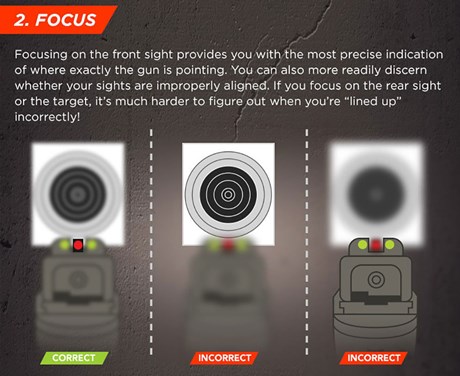Understanding Sight Alignment: A Comprehensive Guide
Sight alignment is a fundamental concept in marksmanship and shooting sports. It refers to the process of aligning the front and rear sights of a firearm to ensure accurate shooting. This guide will delve into the intricacies of sight alignment, its importance in shooting, techniques for achieving proper alignment, and the differences between sight alignment and sight picture. Additionally, we will provide practical tips for improving your shooting accuracy and answer frequently asked questions.
Table of Contents
- What is Sight Alignment?
- Importance of Sight Alignment
- Components of Sight Alignment
- 3.1. Front Sight
- 3.2. Rear Sight
- Sight Alignment Techniques
- Sight Picture vs. Sight Alignment
- Practical Tips for Improving Sight Alignment
- Common Mistakes in Sight Alignment
- Conclusion
- FAQ Section
- References
1. What is Sight Alignment?
Sight alignment is the process of positioning the front and rear sights of a firearm in such a way that they are aligned with each other and the target. This alignment is crucial for accurate shooting, as it determines where the bullet will strike. Proper sight alignment ensures that the shooter can consistently hit their intended target.
Key Definitions
- Front Sight: The sight located at the front end of the firearm, typically a post or blade that the shooter aims at the target.
- Rear Sight: The sight located at the back of the firearm, which helps the shooter align the front sight with the target.
2. Importance of Sight Alignment
The significance of sight alignment in shooting cannot be overstated. Here are several reasons why it is essential:
- Accuracy: Proper sight alignment is critical for hitting the target. Misalignment can result in shots landing far from the intended point of impact.
- Consistency: Consistent sight alignment allows shooters to develop muscle memory, leading to improved performance over time.
- Confidence: Knowing how to align sights correctly boosts a shooter’s confidence, making them more comfortable during practice and competition.
- Safety: Proper sight alignment helps ensure that the shooter is aiming at the intended target, reducing the risk of accidental injury or damage.
3. Components of Sight Alignment
3.1. Front Sight
The front sight is a crucial component of sight alignment. It is typically a post or blade that is positioned above the barrel of the firearm. The shooter must focus on the front sight while aiming, ensuring it is aligned with the target.
Characteristics of Front Sights
- Shape: Front sights can vary in shape, including square, round, or triangular.
- Height: The height of the front sight can affect the shooter’s ability to align it with the rear sight and target.
- Color: Many shooters prefer brightly colored front sights for better visibility against the target.
3.2. Rear Sight
The rear sight complements the front sight and is typically located at the back of the firearm. It helps the shooter align the front sight with the target.
Characteristics of Rear Sights
- Type: Rear sights can be open (notched) or aperture (peep) sights. Open sights provide a wider field of view, while aperture sights offer greater precision.
- Adjustability: Some rear sights are adjustable for windage (horizontal alignment) and elevation (vertical alignment), allowing shooters to fine-tune their aim.
4. Sight Alignment Techniques
Achieving proper sight alignment requires practice and attention to detail. Here are some techniques to help improve your sight alignment:
4.1. Focus on the Front Sight
When aiming, the shooter should focus their vision on the front sight rather than the target or rear sight. This technique ensures that the front sight is sharp and clear, while the rear sight and target may appear slightly blurry.
4.2. Align the Sights
To achieve proper sight alignment, the shooter should ensure that the top of the front sight is level with the top of the rear sight. Additionally, there should be equal space on either side of the front sight within the rear sight notch.
4.3. Use a Consistent Grip
A consistent grip on the firearm helps maintain sight alignment. The shooter should ensure that their grip does not shift between shots, which can lead to misalignment.
4.4. Practice Dry Firing
Dry firing, or practicing trigger control without live ammunition, allows shooters to focus on sight alignment without the distraction of recoil. This practice helps reinforce muscle memory and improve overall accuracy.
5. Sight Picture vs. Sight Alignment
While sight alignment and sight picture are closely related concepts, they are not the same. Understanding the difference is crucial for effective shooting.
Sight Alignment
As previously discussed, sight alignment refers to the positioning of the front and rear sights in relation to each other and the target. It focuses on ensuring that the sights are properly aligned before taking a shot.
Sight Picture
Sight picture is the visual representation of the alignment of the sights with the target. It encompasses what the shooter sees when aiming, including the front sight, rear sight, and target. A proper sight picture is achieved when the sights are aligned and aimed at the intended target.
Key Differences
| Aspect | Sight Alignment | Sight Picture |
|---|---|---|
| Definition | Positioning of front and rear sights | Visual representation of sights and target |
| Focus | Ensures sights are aligned | Ensures sights are aimed at the target |
| Importance | Critical for accuracy | Important for achieving a successful shot |
6. Practical Tips for Improving Sight Alignment
Improving sight alignment requires practice and attention to detail. Here are some tips to help you enhance your skills:
6.1. Regular Practice
Consistent practice is essential for mastering sight alignment. Spend time at the range focusing on aligning your sights and developing muscle memory.
6.2. Use Quality Equipment
Invest in quality sights and firearms that suit your shooting style. High-quality sights can improve visibility and accuracy.
6.3. Seek Professional Instruction
Consider taking lessons from a qualified instructor who can provide personalized feedback and guidance on improving your sight alignment technique.
6.4. Analyze Your Performance
After each shooting session, take time to analyze your performance. Identify areas where you struggled with sight alignment and focus on improving those aspects in future practice.
7. Common Mistakes in Sight Alignment
Even experienced shooters can make mistakes when it comes to sight alignment. Here are some common pitfalls to avoid:
7.1. Focusing on the Target
Many shooters make the mistake of focusing on the target instead of the front sight. This can lead to misalignment and inaccurate shots.
7.2. Improper Grip
An inconsistent or improper grip can affect sight alignment. Ensure that your grip is firm and consistent throughout your shooting practice.
7.3. Rushing the Shot
Taking a shot too quickly can lead to poor sight alignment. Take your time to ensure that your sights are properly aligned before pulling the trigger.
7.4. Neglecting to Adjust Sights
If you consistently miss your target, it may be necessary to adjust your sights. Regularly check your equipment to ensure that everything is aligned correctly.
8. Conclusion
Sight alignment is a critical component of accurate shooting. By understanding the principles of sight alignment and practicing proper techniques, shooters can improve their accuracy and overall performance. Regular practice, quality equipment, and attention to detail are essential for mastering this fundamental skill. Whether you are a beginner or an experienced shooter, focusing on sight alignment will enhance your shooting experience and help you achieve your goals.
9. FAQ Section
Q1: What is the ideal sight alignment?
A1: Ideal sight alignment involves the front sight being centered within the rear sight notch, with equal space on either side and the tops of the sights level with each other.
Q2: How can I improve my sight alignment?
A2: Regular practice, focusing on the front sight, using quality equipment, and seeking professional instruction can help improve your sight alignment.
Q3: What is the difference between sight alignment and sight picture?
A3: Sight alignment refers to the positioning of the front and rear sights, while sight picture is the visual representation of the sights aligned with the target.
Q4: Why is focusing on the front sight important?
A4: Focusing on the front sight ensures that it is sharp and clear, which is crucial for accurate shooting. The target and rear sight may appear blurry, but the front sight should be in focus.
Q5: Can I practice sight alignment without live ammunition?
A5: Yes, dry firing is an effective way to practice sight alignment without live ammunition. It helps reinforce muscle memory and improve overall accuracy.
10. References
For more information on sight alignment and shooting techniques, you can refer to the Wikipedia page on marksmanship here.
Read more about it:https://greyhoundsverdevalley.com/how-to-record-on-google-slides/



